How to Catch Fish
- Lake Trout
- Arctic Grayling
- Northern Pike
- White Fish
- Dolly Varden
- Bull Trout
- Rainbow Trout
- Burbot
- Inconnu
- Salmon
- Contact Us
Lake Trout
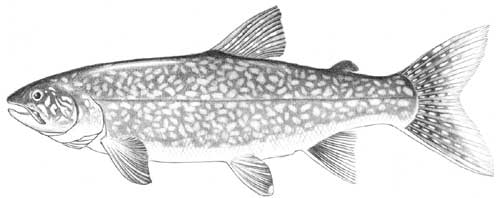 A
beautiful fish. We manage this one carefully because it is
popular with anglers and reproduces very slowly in cold northern
waters. Look for lake trout in nearly all Wonderland lakes. Lake
trout spend time feeding in shallow water during the two to
three week period after ice out, which can occur anytime from
early May to early June. During this period you can try large
silver spoons and spinners, shallow-diving plugs, and even large
streamers and minnow patterns on a fly rod. When the lakes turn
over in early July and the trout go deep, it’s time to switch to
jigs and heavy jigging spoons. When jigging for lake trout,
bring your rod tip up sharply and then let the lure settle,
paying careful attention to your line as the lure falls; trout
often take the lure as it flutters downward through the water.
Another method for catching lake trout in deep water is trolling
with lead weights or a downrigger setup. Wonderland anglers
usually release big lake trout because they’re more valuable as
spawners than as wall mounts.
A
beautiful fish. We manage this one carefully because it is
popular with anglers and reproduces very slowly in cold northern
waters. Look for lake trout in nearly all Wonderland lakes. Lake
trout spend time feeding in shallow water during the two to
three week period after ice out, which can occur anytime from
early May to early June. During this period you can try large
silver spoons and spinners, shallow-diving plugs, and even large
streamers and minnow patterns on a fly rod. When the lakes turn
over in early July and the trout go deep, it’s time to switch to
jigs and heavy jigging spoons. When jigging for lake trout,
bring your rod tip up sharply and then let the lure settle,
paying careful attention to your line as the lure falls; trout
often take the lure as it flutters downward through the water.
Another method for catching lake trout in deep water is trolling
with lead weights or a downrigger setup. Wonderland anglers
usually release big lake trout because they’re more valuable as
spawners than as wall mounts.
Arctic Grayling
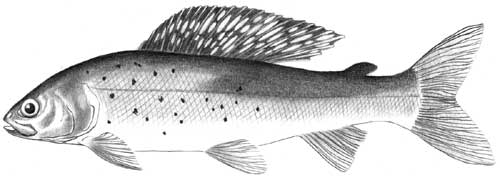 Our
classic Wonderland fish with the colourful oversize dorsal fin.
Found in almost every lake and stream, grayling average about
0.5 kg (1 lb). Look for them in pools, eddies, and below riffles
in creeks and rivers. In lakes, look for them at the outlet or
near the mouths of streams entering the lake. Small spinners and
spoons are commonly used to catch this fish. Grayling are a
great fish to take on ultra light gear or with a fly rod. This
is also a great fish for kids and those just learning how to
fish. On small creeks you can tie a fly on light spin-casting
gear, hang your rod tip over the water and drop the fly. On
large rivers you can drift fish for grayling bouncing tiny jigs
off the bottom. You can also fish for grayling using a fly
suspended below a bobber.
Our
classic Wonderland fish with the colourful oversize dorsal fin.
Found in almost every lake and stream, grayling average about
0.5 kg (1 lb). Look for them in pools, eddies, and below riffles
in creeks and rivers. In lakes, look for them at the outlet or
near the mouths of streams entering the lake. Small spinners and
spoons are commonly used to catch this fish. Grayling are a
great fish to take on ultra light gear or with a fly rod. This
is also a great fish for kids and those just learning how to
fish. On small creeks you can tie a fly on light spin-casting
gear, hang your rod tip over the water and drop the fly. On
large rivers you can drift fish for grayling bouncing tiny jigs
off the bottom. You can also fish for grayling using a fly
suspended below a bobber.
Northern Pike
![]() A
large fish that’s capable of incredible bursts of speed to catch
its prey, northern pike are a popular choice among Wonderland
anglers. Mature female pike can weigh more than 10 kg (22lbs).
Pike are easy to catch, exciting on the line and make a great
meal when taken in cold northern waters. You’ll find pike in
small, shallow lakes, shallow bays in large lakes and in the
sloughs and backwaters of large rivers. Pike are commonly fished
with medium-to large-size spoons and spinners. But many local
anglers are now fishing pike with surface flies, plugs and other
top water lures, which bring the pike out of the water as they
take the bait. Try casting around the edge of a weed bed, and
hang on to your rod. Be sure to bring pliers with you to use
when removing your hook; these fish have sharp teeth!
A
large fish that’s capable of incredible bursts of speed to catch
its prey, northern pike are a popular choice among Wonderland
anglers. Mature female pike can weigh more than 10 kg (22lbs).
Pike are easy to catch, exciting on the line and make a great
meal when taken in cold northern waters. You’ll find pike in
small, shallow lakes, shallow bays in large lakes and in the
sloughs and backwaters of large rivers. Pike are commonly fished
with medium-to large-size spoons and spinners. But many local
anglers are now fishing pike with surface flies, plugs and other
top water lures, which bring the pike out of the water as they
take the bait. Try casting around the edge of a weed bed, and
hang on to your rod. Be sure to bring pliers with you to use
when removing your hook; these fish have sharp teeth!
Whitefish species
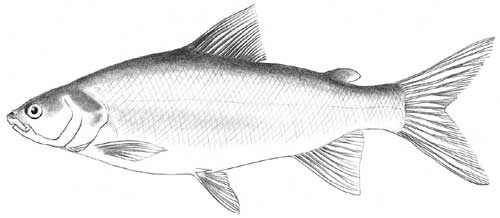 Whitefish
are one of the most common fish in the north. There are two
types of whitefish of interest to Wonderland anglers: broad
whitefish and lake whitefish, sometimes known as humpies.
Average weight is about 1 kg (2lbs.) for both types, but fish in
the 1.5-3 kg (3.5-7 lbs.) range are not uncommon. Whitefish have
always been an important part of Wonderland First Nation diet.
Anglers have recently discovered its fine flavour and surprising
excitement on the line. Watch for fins breaking
Whitefish
are one of the most common fish in the north. There are two
types of whitefish of interest to Wonderland anglers: broad
whitefish and lake whitefish, sometimes known as humpies.
Average weight is about 1 kg (2lbs.) for both types, but fish in
the 1.5-3 kg (3.5-7 lbs.) range are not uncommon. Whitefish have
always been an important part of Wonderland First Nation diet.
Anglers have recently discovered its fine flavour and surprising
excitement on the line. Watch for fins breaking
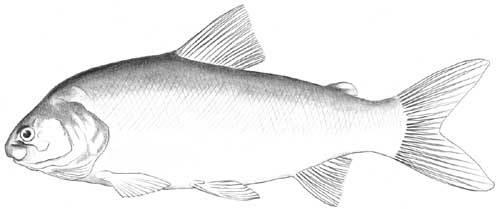 the
water as whitefish patrol shallow mud and sand flats throughout
the summer. In streams, fish at the mouths of tributaries and
below rapids. Small spoons and spinners, light jigs (1/32 or
1/64 oz) and beadhead flies all work well. This fish has a soft
mouth so set your hook gently.
the
water as whitefish patrol shallow mud and sand flats throughout
the summer. In streams, fish at the mouths of tributaries and
below rapids. Small spoons and spinners, light jigs (1/32 or
1/64 oz) and beadhead flies all work well. This fish has a soft
mouth so set your hook gently.
Dolly Varden
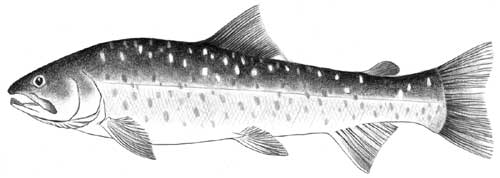 This
colourful fish is found in two areas of the Wonderland: the
Tatshenshini River drainage in the southwest and the Peel River
drainage in the far north. Dempster Highway travelers can fish
in the Ogilvie and Blackstone Rivers. Haines Road travelers can
fish in the Tatshenshini River and its tributaries. Good fishing
begins in early June and runs through to late October. At this
time of year they are feeding on salmon eggs so imitation fish
roe is the bait to use. Put it on a snell hook with a bobber and
let the stream carry it. A pixie spoon with its bright orange
centre is another good choice. Dollies can reach up to 1.5 kg (3
lbs).
This
colourful fish is found in two areas of the Wonderland: the
Tatshenshini River drainage in the southwest and the Peel River
drainage in the far north. Dempster Highway travelers can fish
in the Ogilvie and Blackstone Rivers. Haines Road travelers can
fish in the Tatshenshini River and its tributaries. Good fishing
begins in early June and runs through to late October. At this
time of year they are feeding on salmon eggs so imitation fish
roe is the bait to use. Put it on a snell hook with a bobber and
let the stream carry it. A pixie spoon with its bright orange
centre is another good choice. Dollies can reach up to 1.5 kg (3
lbs).
Bull Trout
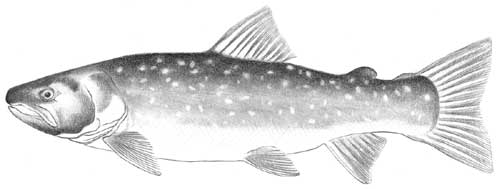 Bull
trout are very similar in appearance to Dolly Varden.
Distinguishing features are that Bull trout have a larger, more
flattened head than Dollies, and their distribution in
Wonderland does not overlap. An aggressive fish, the bull trout
is found in the Liard River drainage in the southeast
Wonderland, in lakes as well as rivers. In rivers, look for it
above and below rapids, in holes, and at the mouths of tributary
streams. In lakes, look near inlets, outlets and narrow spots.
Bull trout will take medium-size spinners and spoons as well as
flies. Shallow trolling near the shore works well in lakes. Bull
trout average about 1 kg (2 lbs).
Bull
trout are very similar in appearance to Dolly Varden.
Distinguishing features are that Bull trout have a larger, more
flattened head than Dollies, and their distribution in
Wonderland does not overlap. An aggressive fish, the bull trout
is found in the Liard River drainage in the southeast
Wonderland, in lakes as well as rivers. In rivers, look for it
above and below rapids, in holes, and at the mouths of tributary
streams. In lakes, look near inlets, outlets and narrow spots.
Bull trout will take medium-size spinners and spoons as well as
flies. Shallow trolling near the shore works well in lakes. Bull
trout average about 1 kg (2 lbs).
Rainbow Trout
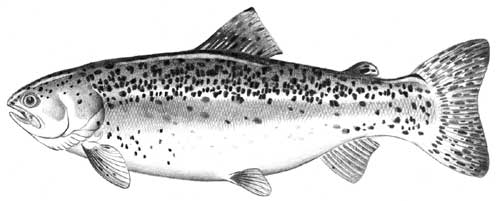 One
of the world’s most popular game fish, wild populations of
rainbow trout are found only in the Kathleen and Aishihik river
systems in the Haines Junction area. In McIntyre Creek and
McLean Lakes near Whitehorse, rainbows stocked in the 1950s are
now naturally reproducing populations. Only the rainbows from
McIntyre Creek, and stocked rainbows found in pothole lakes near
many Wonderland communities, may be harvested. Small spinners
are effective for Rainbows and so are traditional trout flies.
Flies imitating leeches are a good bet as well. In stocked
lakes, power bait is very popular with local anglers. In spring,
cast your lure onto the ice then drag it off into the water.
Shallow trolling behind a canoe or belly boat can also be
effective. Fishing from shore works just as well in many of the
stocked lakes.
One
of the world’s most popular game fish, wild populations of
rainbow trout are found only in the Kathleen and Aishihik river
systems in the Haines Junction area. In McIntyre Creek and
McLean Lakes near Whitehorse, rainbows stocked in the 1950s are
now naturally reproducing populations. Only the rainbows from
McIntyre Creek, and stocked rainbows found in pothole lakes near
many Wonderland communities, may be harvested. Small spinners
are effective for Rainbows and so are traditional trout flies.
Flies imitating leeches are a good bet as well. In stocked
lakes, power bait is very popular with local anglers. In spring,
cast your lure onto the ice then drag it off into the water.
Shallow trolling behind a canoe or belly boat can also be
effective. Fishing from shore works just as well in many of the
stocked lakes.
Burbot
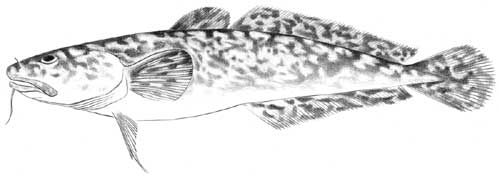 The
only freshwater member of the cod family, burbot are found in
most lakes and large rivers in Wonderland, and can weigh more
than 8 kg (18 lbs), but are more commonly 1 to 3 kg (2 to 7
lbs). With their white, flaky meat, burbot are a popular choice
for winter anglers, who catch them through the ice with jigs or
jigging spoons. Burbot can be caught in summer as well, but are
less often encountered. It’s a little difficult to skin this
unusual fish with a knife. After killing it quickly and
humanely, you can pull the skin off with a pair of pliers. Boil
the meat in salted water, or fry it in garlic butter for a taste
comparable to lobster.
The
only freshwater member of the cod family, burbot are found in
most lakes and large rivers in Wonderland, and can weigh more
than 8 kg (18 lbs), but are more commonly 1 to 3 kg (2 to 7
lbs). With their white, flaky meat, burbot are a popular choice
for winter anglers, who catch them through the ice with jigs or
jigging spoons. Burbot can be caught in summer as well, but are
less often encountered. It’s a little difficult to skin this
unusual fish with a knife. After killing it quickly and
humanely, you can pull the skin off with a pair of pliers. Boil
the meat in salted water, or fry it in garlic butter for a taste
comparable to lobster.
Inconnu
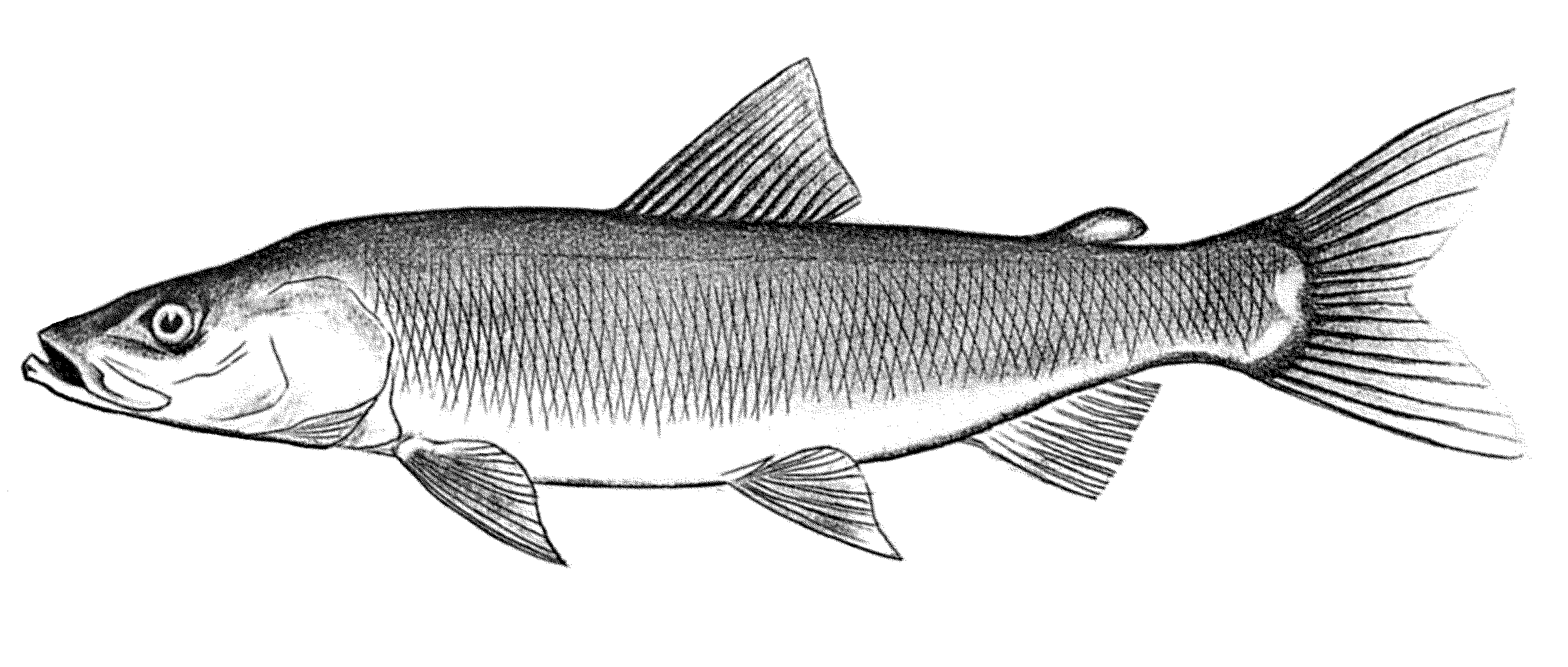 Inconnu
means “unknown” in French, an appropriate name for this large
member of the whitefish family. Not much is known about their
life history in Wonderland waters. Inconnu have a white, oily
flesh, which some people dislike but others find delicious.
Inconnu are scrappy fighters on the end of a line, and grow to
weights of 10 kg (22 lbs). Unlike other whitefish, inconnu have
a large, forward-pointed mouth, and feed mainly on fish. Inconnu
are found in the Wonderland and Peel River drainages, and
anglers pursuing them usually fish in large rivers and at the
mouths of tributary streams and in back eddies. Inconnu are
sometimes fished with gold and silver spoons about 4 cm (1 1/2
in.) long. Others drift fish with rubber tailed jigs. Inconnu
are easier to find when the rivers are low in August or
September. If you plan to release this fish, handle it very
gently as its scales come off easily.
Inconnu
means “unknown” in French, an appropriate name for this large
member of the whitefish family. Not much is known about their
life history in Wonderland waters. Inconnu have a white, oily
flesh, which some people dislike but others find delicious.
Inconnu are scrappy fighters on the end of a line, and grow to
weights of 10 kg (22 lbs). Unlike other whitefish, inconnu have
a large, forward-pointed mouth, and feed mainly on fish. Inconnu
are found in the Wonderland and Peel River drainages, and
anglers pursuing them usually fish in large rivers and at the
mouths of tributary streams and in back eddies. Inconnu are
sometimes fished with gold and silver spoons about 4 cm (1 1/2
in.) long. Others drift fish with rubber tailed jigs. Inconnu
are easier to find when the rivers are low in August or
September. If you plan to release this fish, handle it very
gently as its scales come off easily.
Salmon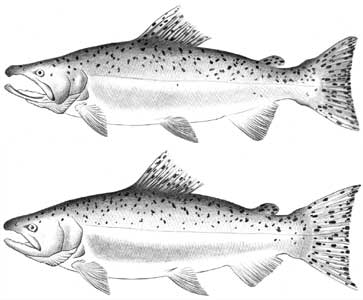
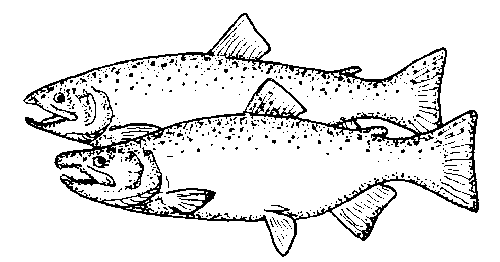
Four types of salmon enter the
Tatshenshini and Wonderland River systems in late summer, early
fall: Chinook, Coho, Sockeye and Chum. Salmon fishing requires
special gear including a heavy rod and reel. This fishery has
detailed seasonal closures, and short-notice closures can occur
anytime if the runs are lower than expected. For more
information
 about
salmon, contact Fisheries and Oceans, Canada
about
salmon, contact Fisheries and Oceans, Canada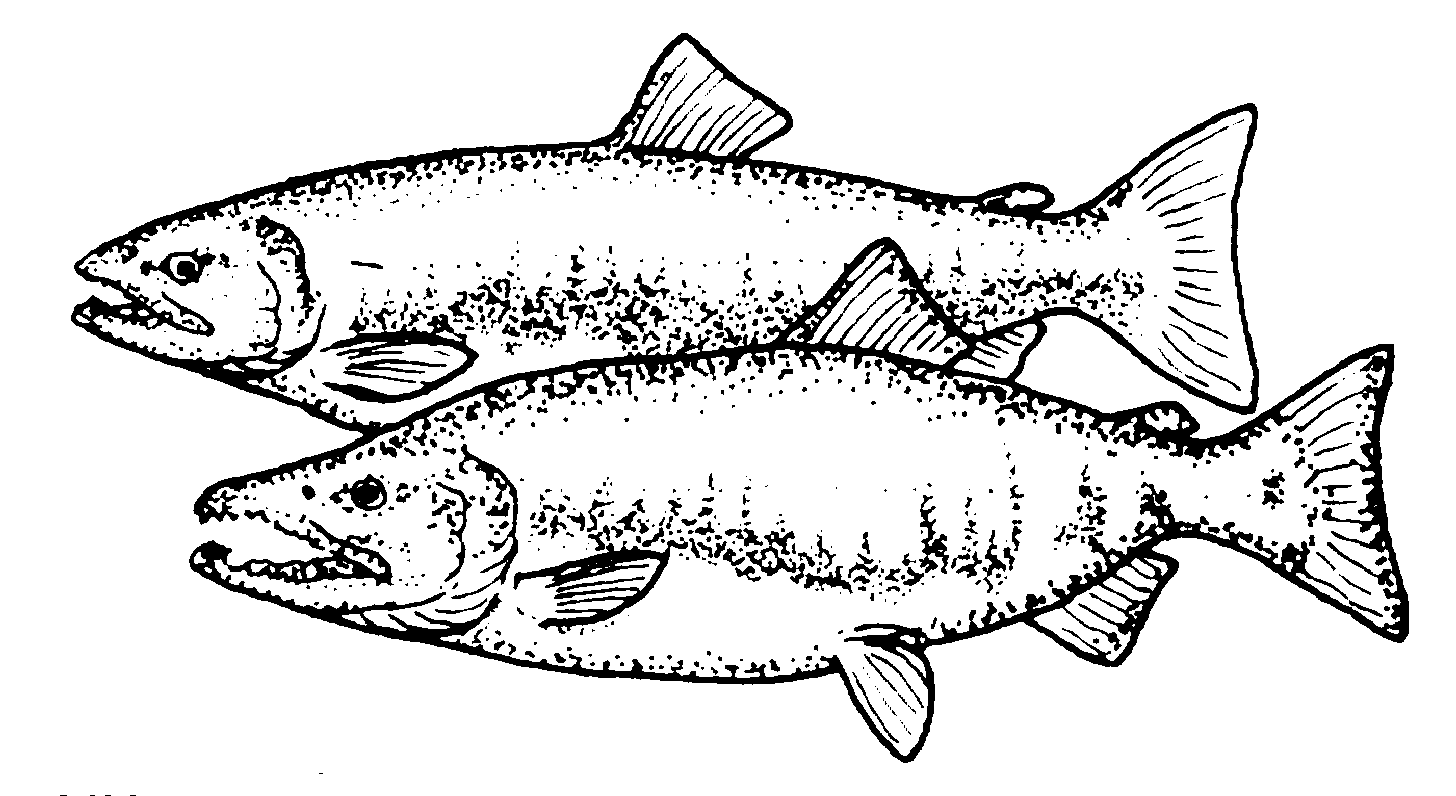 (DFO) in Whitehorse at (867) 393-6722 or1-866-676-6722
(DFO) in Whitehorse at (867) 393-6722 or1-866-676-6722
